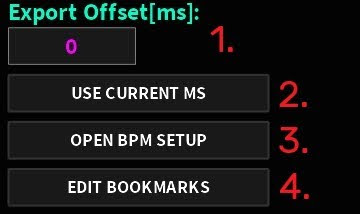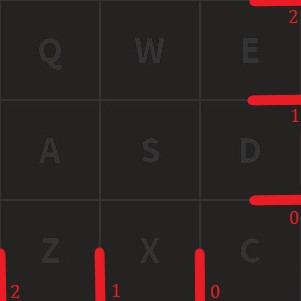Map creation
Learn how to make your very own maps using the Sound Space Quantum Editor (SSQE)
Creating a map
On the menu that has popped up, you will see the following options:
- Create New Map: used to create a new empty map as well as its asset file.
- Load Map: used for loading saved maps.
- Import Map: used to import map data (raw data / GitHub links).
- Settings: mostly used for customizing.
- Autosaved Map: used to load an autosaved map, if one exists.
- Edit Last Map: used to load the last manually saved map.
Head over to Create New Map to create a new map, then get an audio file of the song you want to map, either in mp3 or ogg audio format. If done correctly, the Editor layout should pop up (first image on the next section).
Details
You'd normally need an audio ID from the Roblox Audio Library to map. However, this method is hardly viable since there are various restrictions over public audios (since March 2022). Therefore, importing audios directly is the best way around.
Timing
Before starting to place notes, it's important to time the map properly using timing points. You can set them up via: Timing > Open Timing Setup:
Inside this menu, we have a few more assets that have to do with timing points:
- Add Point: Adds a new Timing Point with said BPM and Offset to the list above. Said list can have as many timing points as needed, but cannot have repeated values.
- Delete Point: Deletes the selected Timing Point(s).
- Update Point: Updates the selected Timing Point(s) with the input BPM/Offset.
- Current Pos: Updates the input Offset to the current position on the track.
- Move Selected Points (ms): Moves the selected Timing Point(s) according to the Offset.
- Importing Timing Points: Using Paste Timings or Open Beatmap Timings, you may be able to import the timing points from another rhythm game's map. The latter supports:
- osu! (any gamemode)
- A Dance Of Fire And Ice (ADOFAI)
- Clone Hero (CH)
- Open BPM Tapper: Allows you to approximate the song’s BPM by tapping a button to the beat.
Details
Check out this article to learn how to map a song manually.
Note placing
Now that you have everything set up, you can start placing down notes. The keybinds are as follows:
- Q or 7 for top left corner (2|2)
- W or 8 for top mid (1|2)
- E or 9 for top right corner (0|2)
- A or 4 for middle left (2|1)
- S or 5 for middle (1|1)
- D or 6 for middle right (0|1)
- Z or 1 for bottom left corner (2|0)
- X or 2 for bottom mid (1|0)
- C or 3 for bottom right corner (0|0)
INFO
If you have an older version of the Editor, you might also be able to use the Y key as bottom left corner.
Details
The numbers represent the (-X|Y) coordinates of the note:
As you can see, the X axis is inverted.
Mapping tips
Lastly, a few tips in case you've never mapped before:
- Play a lot of different maps before mapping.
- Make sure you can beat your own maps, playtesting is key to produce good maps.
- Use BPM and Offset properly. This DOES make a big difference once you get the hang of it.
- Avoid using weird beat divisors, anything other than 1, 2, 4, 6, 8, 12 or 16, while you’re starting.
- Do not overcomplicate things. Focus on making fun maps first, then move on towards representation and creativity.
- Do not rush, especially when you’re new to mapping. And most importantly, follow the community guidelines and have fun mapping!
Saving
Once you have finished mapping, you can save the map in three different ways:
- Clicking Ctrl + S: Triggers a data overwrite, meaning your older save will be replaced.
- Automatically: Automatically overwrites the map’s data with a certain frequency (changed via Settings)
- Clicking Back to Menu: Triggers a popup which will ask the user to save before closing the map.
TIP
It is recommended that every map you make is stored in the Editor’s folder, so you won’t lose any.
You may even have map folders inside of it!
You might notice that a .ini file has saved along with your map.
This file includes the map's timing assets, so make sure you don't delete it.
If everything went fine until now, you should have created your first map! Congratulations!